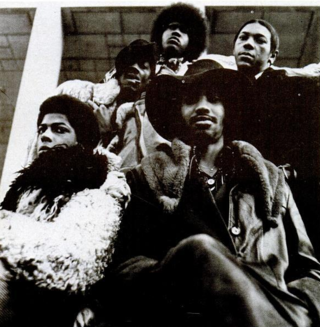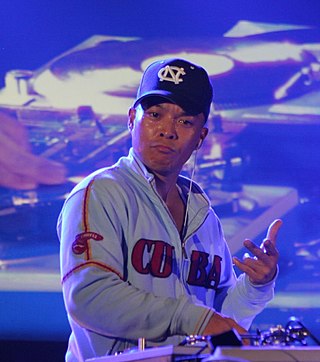Related Research Articles

Funk is a music genre that originated in Black American communities in the mid-1960s when musicians created a rhythmic, danceable new form of music through a mixture of various music genres that were popular among African Americans in the mid-20th century. It de-emphasizes melody and chord progressions and focuses on a strong rhythmic groove of a bassline played by an electric bassist and a drum part played by a percussionist, often at slower tempos than other popular music. Funk typically consists of a complex percussive groove with rhythm instruments playing interlocking grooves that create a "hypnotic" and "danceable" feel. Funk uses the same richly colored extended chords found in bebop jazz, such as minor chords with added sevenths and elevenths, or dominant seventh chords with altered ninths and thirteenths.
Breakbeat hardcore is a music genre that spawned from the UK rave scene during the early 1990s. It combines four-on-the-floor rhythms with breakbeats usually sampled from hip hop. In addition to the inclusion of breakbeats, the genre also features shuffled drum machine patterns, hoover, and other noises originating from new beat and Belgian techno, sounds from acid house and bleep techno, and often upbeat house piano riffs and vocals.
Breakbeat is a broad type of electronic music that tends to use drum breaks sampled from early recordings of funk, jazz, and R&B. Breakbeats have been used in styles such as hip hop, jungle, drum and bass, big beat, breakbeat hardcore, and UK garage styles.

Funkadelic was an American funk rock band formed in Plainfield, New Jersey, in 1968 and active until 1982. The band and its sister act Parliament, both led by George Clinton, pioneered the funk music culture of the 1970s. Initially formed as a backing band for Clinton's vocal group the Parliaments, Funkadelic eventually pursued a heavier, more psychedelic rock-oriented sound. They released acclaimed albums such as Maggot Brain (1971) and One Nation Under a Groove (1978).

Turntablism is the art of manipulating sounds and creating new music, sound effects, mixes and other creative sounds and beats, typically by using two or more turntables and a cross fader-equipped DJ mixer. The mixer is plugged into a PA system and/or broadcasting equipment so that a wider audience can hear the turntablist's music. Turntablists atypically manipulate records on a turntable by moving the record with their hand to cue the stylus to exact points on a record, and by touching or moving the platter or record to stop, slow down, speed up or, spin the record backwards, or moving the turntable platter back and forth, all while using a DJ mixer's crossfader control and the mixer's gain and equalization controls to adjust the sound and level of each turntable. Turntablists typically use two or more turntables and headphones to cue up desired start points on different records.

In music, groove is the sense of an effect ("feel") of changing pattern in a propulsive rhythm or sense of "swing". In jazz, it can be felt as a quality of persistently repeated rhythmic units, created by the interaction of the music played by a band's rhythm section. Groove is a significant feature of popular music, and can be found in many genres, including salsa, rock, soul, funk, and fusion.
Hardcore is a genre of electronic dance music that originated in the United Kingdom, the Netherlands, Belgium and Germany in the early 1990s. It is distinguished by faster tempos and a distorted sawtooth kick, the intensity of the kicks and the synthesized bass, the rhythm and the atmosphere of the themes, the usage of saturation and experimentation close to that of industrial dance music. It would spawn subgenres such as gabber.
Electro is a genre of electronic music and early hip hop directly influenced by the use of the Roland TR-808 drum machines, and funk. Records in the genre typically feature drum machines and heavy electronic sounds, usually without vocals, although if vocals are present they are delivered in a deadpan manner, often through electronic distortion such as vocoding and talkboxing. This is the main distinction between electro and previously prominent genres such as disco, in which the electronic sound was only part of the instrumentation. It also palpably deviates from its predecessor boogie by being less vocal-oriented and more focused on electronic beats produced by drum machines.
An orchestra hit, also known as an orchestral hit, orchestra stab, or orchestral stab, is a synthesized sound created through the layering of the sounds of a number of different orchestral instruments playing a single staccato note or chord. The orchestra hit sound was propagated by the use of early samplers, particularly the Fairlight CMI where it was known as the ORCH5 sample. The sound is used in pop, hip hop, jazz fusion, techno, and video game genres to accentuate passages of music.
In popular music, a break is an instrumental or percussion section during a song derived from or related to stop-time – being a "break" from the main parts of the song or piece. A break is usually interpolated between sections of a song, to provide a sense of anticipation, signal the start of a new section, or create variety in the arrangement.

Dance music is music composed specifically to facilitate or accompany dancing. It can be either a whole piece or part of a larger musical arrangement. In terms of performance, the major categories are live dance music and recorded dance music. While there exist attestations of the combination of dance and music in ancient times, the earliest Western dance music that we can still reproduce with a degree of certainty are old fashioned dances. In the Baroque period, the major dance styles were noble court dances. In the classical music era, the minuet was frequently used as a third movement, although in this context it would not accompany any dancing. The waltz also arose later in the classical era. Both remained part of the romantic music period, which also saw the rise of various other nationalistic dance forms like the barcarolle, mazurka, ecossaise, ballade and polonaise.
The stutter edit, or stutter effect, is the rhythmic repetition of small fragments of audio, occurring as the common 16th note repetition, but also as 64th notes and beyond, with layers of digital signal processing operations in a rhythmic fashion based on the overall length of the host tempo. The Stutter Edit audio software VST plug-in implements forms of granular synthesis, sample retrigger, and various effects to create a certain audible manipulation of the sound run through it, in which fragments of audio are repeated in rhythmic intervals. The plug-in allows musicians to manipulate audio in real time, slicing audio into small fragments and sequences the pieces into rhythmic effects, recreating techniques that formerly took hours to do in the studio. Electronic musician Brian Transeau is widely recognized for pioneering the stutter edit as a musical technique; he developed, coined the term, and holds multiple patents for the Stutter Edit software plug-in.
Hip hop music or hip-hop music, also known as rap music and formerly known as disco rap, is a genre of popular music that originated in the Bronx borough of New York City in the early 1970s by African Americans, and it had been around for years prior before mainstream discovery. This genre of music originated as anti-drug and anti-violence, while consisting of stylized rhythmic music that commonly accompanies rapping, a rhythmic and rhyming speech that is chanted. According to the professor Asante of African American studies at Temple University, “hip hop is something that blacks can unequivocally claim as their own”. It was developed as part of hip hop culture, a subculture defined by four key stylistic elements: MCing/rapping, DJing/scratching with turntables, break dancing, and graffiti art. Other elements include sampling beats or bass lines from records, and rhythmic beatboxing. While often used to refer solely to rapping, "hip hop" more properly denotes the practice of the entire subculture. The term hip hop music is sometimes used synonymously with the term rap music, though rapping is not a required component of hip hop music; the genre may also incorporate other elements of hip hop culture, including DJing, turntablism, scratching, beatboxing, and instrumental tracks.
Boom bap is a subgenre and music production style that was prominent in East Coast hip hop during the golden age of hip hop from the late 1980s to the early 1990s.
References
- ↑ Lodder, Steve (2005). Stevie Wonder: A Musical Guide to the Classic Albums. Backbeat. p. 106. ISBN 0879308214.
- ↑ Weinel, Jonathan (2018). Inner Sound: Altered States of Consciousness in Electronic Music and Audio-visual Media. Oxford University Press. pp. 86–87. ISBN 978-0190671181.
- ↑ David M. (3 December 2013). "History of UK hardcore rave music". Toucan Music. Retrieved 15 May 2021.
- ↑ Marshall, Wayne (2002). Producing the Real: Hip-hop Music and Authenticity. University of Wisconsin–Madison. pp. 50–51. OCLC 608820774.